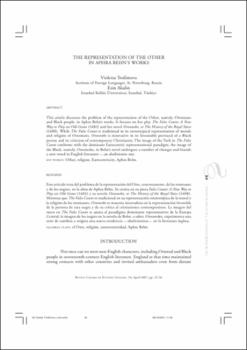The Representation of the Other in Aphra Behn's Works
Fecha
2007Resumen
Este artículo trata del problema de la representación del Otro, concretamente, de los otomanos y de los negros, en la obra de Aphra Behn. Se centra en su pieza False Count: A New Way to Play an Old Game (1682) y su novela Oroonoko, or The History of the Royal Slave (1688). Mientras que The False Count es tradicional en su representación estereotípica de la moral y la religión de los otomanos, Oroonoko se muestra innovadora en la representación favorable
de la persona de raza negra y de su crítica al cristianismo contemporáneo. La imagen del turco en The False Count se ajusta al paradigma dominante representativo de la Europa Central; la imagen de los negros en la novela de Behn, a saber, Oroonoko, experimenta una serie de cambios y origina una nueva tendencia —abolicionista— en la literatura inglesa. This article discusses the problem of the representation of the Other, namely, Ottomans
and Black people, in Aphra Behn’s works. It focuses on her play The False Count: A New
Way to Play an Old Game (1682) and her novel Oroonoko, or The History of the Royal Slave
(1688). While The False Count is traditional in its stereotypical representation of morals
and religion of Ottomans, Oroonoko is innovative in its favourable portrayal of a Black
person and its criticism of contemporary Christianity. The image of the Turk in The False
Count conforms with the dominant Eurocentric representational paradigm; the image of
the Black, namely, Oroonoko, in Behn’s novel undergoes a number of changes and founds
a new trend in English literature —an abolitionist one.





